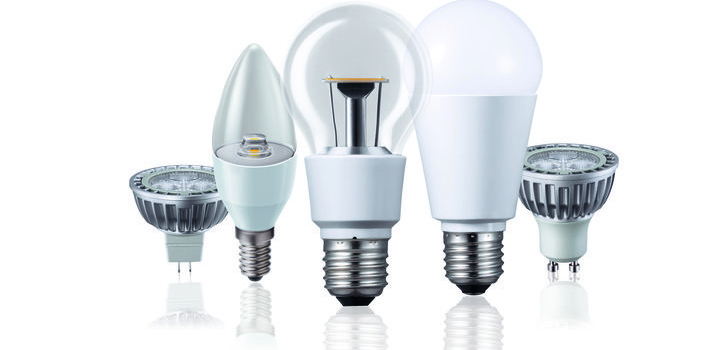
Update: Please scroll to the bottom of the article to find out more about the new legislation affecting halogen bulbs in 2018
Comparing LEDs with Traditional Halogen Lighting
LED bulbs are the (relative) new kids on the block when it comes to home lighting and if you go in to a shop today to buy one you will see that they are considerably more expensive to purchase than traditional halogen bulbs. Is the extra upfront expense worth it?
The answer, as our numbers suggest below, is a resounding yes!
The table below shows the lifetime costs associated with running a 5w LED spotlight versus a 50w halogen spotlight.
| Type of lightbulb | 5 Watt LED Spotlight | 50 Watt Halogen |
|---|---|---|
| Cost per bulb | £5.00 | £1.50 |
| Cost of electricity (@ £0.15 / kWh) | £18.00 | £180.00 |
| Light bulb projected Lifespan (Hrs) | 24,000 | 2,000 |
| Bulbs needed to last 24,000 hours | 1 | 12 |
| Bulb price | £5.00 | £18.00 |
| Total cost of buying and running the bulb | £23.00 | £198.00 |
So this shows that for each halogen bulb you replace with an LED equivalent, you are potentially going to save £175 over its lifetime.
The table below shows you typical savings per year – based on 5 hours usage per day (typical for a kitchen or lounge).
| Type of lightbulb | 5 Watt LED Spotlight | 50 Watt Halogen |
|---|---|---|
| kWh used per year | 9.13 | 91.25 |
| Cost of electricity per year (@ £0.15 / kWh) | £1.37 | £13.69 |
So based on the fact that you are saving about £12 per year on each bulb, the payback is a little over a year if you were to use them for 5 hours per day!
The final table looks at the savings you can make from swapping out 6 halogen spotlights in your kitchen with 6 5W LED bulbs, and it assumes that you only buy new halogen bulbs every two years – so every 3650 hours (instead of the 2000 hours which is their expected lifeline, we need to give them a chance!).
>>> Click here to see our comparison between MR16 LED bulbs with GU10 LED <<<
The yearly energy costs are as follows:
For LED bulbs – 6 x £1.37 = £8.22
For Halogen bulbs – 6 x £13.69 = £82.13
| 5w LED Yearly Costs | 50w Halogen Yearly Costs | |||||
| Electricity Cost | Cost of Bulb | Cumulative Cost | Electricity Cost | Cost of Bulb | Cumulative Cost | |
| Year 0 | £0.00 | £25.00 | £25.00 | £0.00 | £7.00 | £7.00 |
| Year 1* | £8.22 | £0.00 | £33.22 | £82.13 | £0.00 | £89.13 |
| Year 2 | £8.22 | £0.00 | £41.44 | £82.13 | £9.00 | £180.26 |
| Year 3 | £8.22 | £0.00 | £49.66 | £82.13 | £0.00 | £262.39 |
| Year 4 | £8.22 | £0.00 | £57.88 | £82.13 | £9.00 | £353.52 |
| Year 5 | £8.22 | £0.00 | £66.10 | £82.13 | £0.00 | £435.65 |
| Year 6 | £8.22 | £0.00 | £74.32 | £82.13 | £9.00 | £526.78 |
| Year 7 | £8.22 | £0.00 | £82.54 | £82.13 | £0.00 | £608.91 |
| Year 8 | £8.22 | £0.00 | £90.76 | £82.13 | £9.00 | £700.04 |
| Year 9 | £8.22 | £0.00 | £98.98 | £82.13 | £0.00 | £782.17 |
| Year 10 | £8.22 | £0.00 | £107.20 | £82.13 | £9.00 | £873.30 |
| Year 11 | £8.22 | £0.00 | £115.42 | £82.13 | £0.00 | £955.43 |
| Year 12 | £8.22 | £0.00 | £123.64 | £82.13 | £9.00 | £1,046.56 |
| Year 13 | £8.22 | £0.00 | £131.86 | £82.13 | £0.00 | £1,128.69 |
| Year 14 | £8.22 | £0.00 | £140.08 | £82.13 | £9.00 | £1,219.82 |
| Year 15 | £8.22 | £0.00 | £148.30 | £82.13 | £0.00 | £1,301.95 |
| Year 16 | £8.22 | £0.00 | £156.52 | £82.13 | £9.00 | £1,393.08 |
| Year 17 | £8.22 | £0.00 | £164.74 | £82.13 | £0.00 | £1,475.21 |
| Year 18 | £8.22 | £0.00 | £172.96 | £82.13 | £9.00 | £1,566.34 |
| Year 19 | £8.22 | £0.00 | £181.18 | £82.13 | £0.00 | £1,648.47 |
| Year 20 | £8.22 | £0.00 | £189.40 | £82.13 | £9.00 | £1,739.60 |
| TOTAL | £164.40 | £25.00 | £189.40 | £1,642.60 | £7.00 | £1,739.60 |
| Type of lightbulb | 5 Watt LED Spotlight | 50 Watt Halogen |
|---|---|---|
| Light bulb projected Lifespan (Hrs) | 24,000 | 2,000 |
| Cost per bulb | £5.00 | £1.50 |
| kWh of electricity used over 24,000 hours | 120 | 1,200 |
| Cost of electricity (@ £0.15 / kWh) | £18.00 | £180.00 |
| Bulbs needed to last 24,000 hours | 1 | 12 |
| Bulb expense | £5.00 | £18.00 |
| Total cost of buying and running the bulb | £23.00 | £198.00 |
LEDs last 12-15 times longer, they use 90% less energy and so overall contribute to enormous savings on your electricity bills – so what are you waiting for? The reason for these savings is because halogen bulbs, much like traditional incandescent bulbs produce light as a by product when they get hot. LED bulbs however work differently – providing light as electrons pass through a semi conductive material, so first and foremost they produce light far more efficiently.

Please remember not all LED bulbs are built the same though, if you want to see why our LEDs are the best, be sure to check out our LED buyers guide!
Update (September 2018): EU Legislation to Ban Halogen
Halogen lightbulbs are soon to become obsolete in the UK following a ban made by the European Union. Retailers will have to replace their stocks of halogen lightbulbs with more energy-efficient alternatives, such as LEDs or compact fluorescent bulbs. If you’ve read the above then you’ll see why we think this is a great thing!












One of the most informative posts i have read on the topic. your cost break down changed my mind and i am now going to fit LED Lighting threw out my house
Please correct my arithmetic. 1 kWh is 1 kW over 1 hour. If it existed, a 1kW bulb would use 1 kW in 1 hour. Over 40000 hours it would use 40000 kW. In 40000 hours a 50W bulb uses 1/20th of that = 2000 kWh. So how did you calculate 1250 hours?
A further request to teach me your arithmetic. A bulb lasts 2000 hours. Over 40000 hours the bulb will be replaced 40000/2000 = 20 times. How did you arrive at 12 bulbs?
Thanks for pointing this out. Not sure why the figures were wrong, but we have now updated the page with more accurate LED costs.
the equivilant of a 50w halogen is a 12w LED not 5w, (which for those reading means your running costs of it are actually twice as much as stated in this article/table and are only saving half of the amount suggested)
Hi. I found this site interesting because I’m trying to reduce our carbon footprint at home,while we live on a tight budget. My question is – if I replace the light bulbs we use most often, which are not expended, with LED, what am I going to do with the bulbs I take out? Do they have to be added to the landfill, which is a huge problem in itself?
Hi, that is not entirely true!! We have 5w bulbs in the office that are very similiar to a 50w. In fact we also have 7w bulbs and these are much brighter.
Obviously the higher the wattage of the bulb used, the higher the electricity usage and the higher the cost, but the figures you have suggested are just not true!
I fitted non-dimmable 6 watt LED spots around the house replacing 8x 35w halogens and 4 x 50w halogen spots. The LED spots are considerably brighter at 370 lumens than even the 50w halogens I was using and are incredible. Whats more they were only £14 for 4 bulbs i.e. £3.50 each. I was wondering how much I would save and am very impressed by what I have worked out can be saved from this post. Very informative. My LED’s have a life of 15,000 hours. B&Q was here I bought them.
Hi lee,
Thanks for the comment. LED bulbs use 90% less energy than the equivalent halogen spots so it is definitely worth swapping over. The only issues we encounter is when people swap out their MR16 halogen bulbs with LED’s becuase they require an external transformer and these don’t tend to be compatible with the new LED bulbs so you get flickering. Our advice would always be to swap to GU10 so swap to a new fitting + bulb rather than trying to get the MR16’s to work with new LED transformer / drivers.
I have just fitted 6x 5.3 watt LEDs and they are brighter than the 50 watt halogen bulbs they have replaced plus being a much warmer / nicer light
5w led is not same as 50 w halogen. The number of hours used is high, many of use don’t use the existing ceiling lights much. ie. the figures are easily debunked. What if I move after five years, the buyer can thank me I guess. What if I rent. I have two GU10s to replace, 8w will get me same brightness. I have four unused GU10 Halogens some years old, so I figure they are free, vs frosted LEDs I would use which are verrry pricey. Analyse your use carefully methinks before splashing out on leds, an 8W LED in 5 years time will be about 20 percent the cost it is now and a better product.
Hi Paul, I appreciated your points – they all do make sense, but we have obviously had to look at standard usage etc. LED bulbs certainly do cost more than their equivalent Halogens, however the energy savings are pretty dramatic so even you move after 5 years they should more than cover the initial cost of buying the bulb.
The fitting I’d like to buy has a recommended bulb of SES eco halogen golf ball. It uses 5 of these. I’d be keen to use LEDs instead. Will any LEDs of suitable wattage be compatible with this? In other words, is it always possible to substitute LEDs for halogen?
This information allows people to choose an appliance at a higher initial cost if they know it’s more efficient and will save them money in the long run.
Useful info – we are looking at making the jump to LED!
Having recently started looking at smart home technology, Amazon Echo, Google Home etc, I realised LED lighting is the way to go.
I’ve started to replace table lamp bulbs, often running halogen bulbs or those awful low energy bulbs which are apparently full of mercury etc with the LED equivalents. What has most impressed me if the quality of the light (warm white), how cheap yet how well made they are, and how cool they are in terms of heat given off.
When it comes to halogen spots, I need to make the switch to GU10 from MR16 fitting and because I’ve got dimmers in most rooms, there is the added cost of buying a new trailing edge dimmer switches where necessary. Plus I will hire an electrician so I know the job is done properly and safely.
Check out the UK pound Shops / discount stores for some real bargains. (bmstores.co.uk, poundworld extra and homebargains.co.uk. Much cheaper than existing supermarkets and DIY stores. Large range at silly prices so you should be making in savings before you know it. eg. Home Bargains have a dimmer 5w (50 watt equivalent) GU10 dimmable spot for just £1.99
If you’re working to a buidget, I think the main rule is to look at which lamps you have on the most and switch those first. Those will be where the greatest savings will be made.
Are there LED bulbs that work with a dimmer switch? I have not found any in the usual stores that I visit so I’ve resorted to halogen.